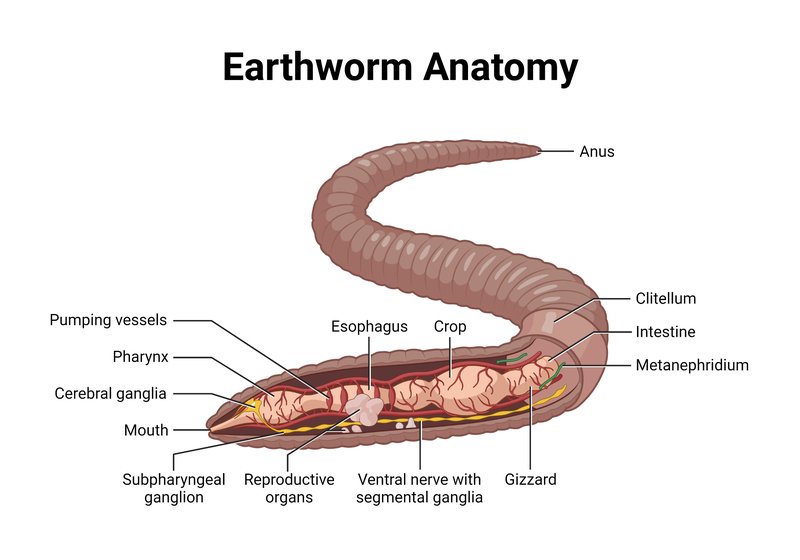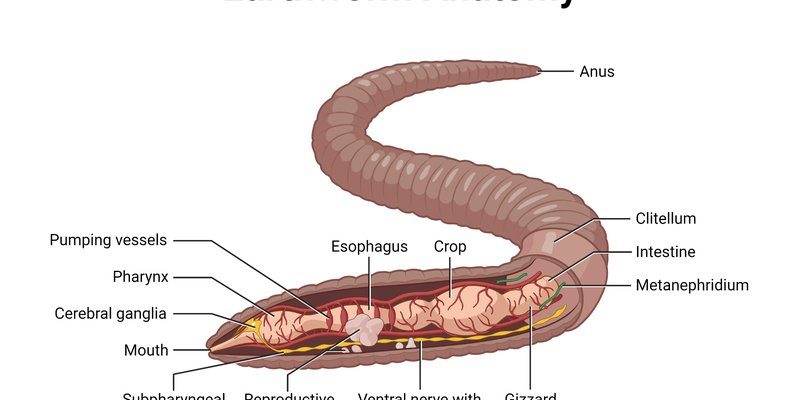
Picture an earthworm as a living, squishy tube. It might not look like much at first glance, but it’s packed with features that help it cut through soil like a hot knife through butter. Think of its segments as tiny compartments, each performing specific functions. The setae are like tiny bristles that help it grip the soil and move about. And the gizzard? That’s where the real magic happens in terms of digestion. So, let’s dive in and explore these amazing structures!
Understanding Earthworm Segments
Earthworms are made up of many **segments**, which are essentially the building blocks of their bodies. Each segment functions independently while contributing to the whole worm’s movement and health. An earthworm can have anywhere from 80 to over 200 segments depending on the species. This segmentation isn’t just for looks; it plays a vital role in how the worm moves and burrows through the earth.
You might be wondering how segments help. Think of each segment as a mini muscle group. When one segment contracts, it pulls the next segment along, allowing the worm to inch forward. This movement is called **peristalsis**. It’s a coordinated contraction and relaxation of the muscles that helps the worm slither through the soil, much like how a snake moves.
But there’s more to segments than just movement. Each segment also houses parts of the worm’s internal systems. For instance, certain segments have **nephridia**, which act like kidneys to excrete waste. This is crucial for the worm’s health, allowing it to maintain balance in its body, so it can live in various soil conditions without getting overwhelmed.
The Role of Setae in Earthworm Mobility
Now, let’s talk about **setae**—those tiny, bristle-like structures on the earthworm’s body. You can think of setae as nature’s little grip pads. These stiff hairs help earthworms anchor themselves in the soil and move effectively. Imagine trying to walk on a slippery surface without any traction; it would be pretty difficult, right? Well, that’s how earthworms would feel without their setae.
Setae are not present on every segment, but they’re strategically located on the ventral side, which is the earthworm’s underside. When an earthworm wants to move, it extends its setae to grip the soil. If you’ve ever tried climbing a steep hill in loose gravel, you’d appreciate how essential this is. Setae provide earthworms with the necessary traction to pull themselves forward while they contract and relax their body segments.
In addition to helping with movement, setae also serve another purpose: stability. As earthworms dig through the earth, they need to keep their bodies steady, especially to prevent collapsing their burrows. With the help of setae, they can maintain their position while pushing through dirt, essentially making them skilled little architects of soil structure.
What is a Gizzard and Its Function?
Next up, let’s explore the **gizzard**. This muscular organ is a true powerhouse in the earthworm’s anatomy, playing a crucial role in digestion. Picture a gizzard as a grinding stone that breaks down food before it moves on to the next part of the digestive system. Earthworms eat organic matter from soil, like decaying leaves and tiny bits of plants, but they need to break it down into smaller pieces first.
The gizzard is located just after the crop, which is where food is initially stored. Once the food hits the gizzard, strong muscles contract to grind it into smaller particles. This process is similar to how we chew our food to make it easier to digest. The ground-up food then moves into the intestine, where it can be absorbed into the worm’s body.
Interestingly, earthworms often consume tiny particles of grit and soil along with their food to aid in this grinding process. It’s like having a built-in kitchen tool that helps prepare their meals. This adaptation is key to their survival and efficiency as decomposers, allowing them to break down organic material and enrich the soil in the process.
How Segments, Setae, and Gizzards Work Together
So, how do segments, setae, and gizzards work together to help the earthworm thrive? It’s all about teamwork. The segments allow for smooth locomotion through the earth, while the setae grip the soil during movement. And the gizzard ensures that the earthworm can efficiently process food it consumes. This perfect harmony is what lets earthworms fulfill their role in the ecosystem.
You can see this teamwork in action when you watch an earthworm move. As it contracts its segments, the setae dig into the soil to hold firm. Once it pushes forward, the gizzard is ready to break down its next meal. It’s a beautifully coordinated dance that has evolved over millions of years, showcasing how nature creates efficient systems.
This collaborative functioning not only benefits the worms but also impacts the larger environment. By aerating the soil and breaking down organic matter, earthworms contribute to a healthy ecosystem, helping to create nutrient-rich soil that supports plant growth. It’s a reminder of how interconnected life is on our planet.
The Importance of Earthworm Anatomy in Ecosystems
Understanding earthworm anatomy helps us appreciate their role in the ecosystem even more. The unique structures, like segments, setae, and gizzards, are crucial for their survival and efficiency as decomposers. Without them, soil quality would deteriorate, impacting everything from agriculture to natural plant growth.
In many ways, earthworms are nature’s unsung heroes. They improve soil structure, promote plant health, and even help with water retention in the soil. By breaking down organic matter, they recycle nutrients that plants rely on. This process supports the entire food chain, making them vital for both gardens and natural landscapes.
If you’re a gardener, you might want to pay extra attention to these fascinating creatures. By fostering a healthy earthworm population in your soil, you’re not just enhancing your garden; you’re contributing to a healthier environment. Earthworms are like little gardeners themselves, working tirelessly beneath the surface to ensure life flourishes above.
So, the next time you see an earthworm wriggling across your path or burrowing into your garden, take a moment to appreciate everything happening beneath that unassuming outer layer. The intricacies of their anatomy—segments acting like coordinated teams, setae providing traction and stability, and gizzards grinding up their meals—come together in a remarkable way.
These little creatures may not seem like much, but they are crucial players in our ecosystem. By understanding their anatomy, we gain insight into their important roles and how they help nurture the world around us. Isn’t it amazing how something so small can make such a big difference? Embracing the wonders of earthworm anatomy can lead to a greater appreciation of our environment and the hidden life that supports it.

